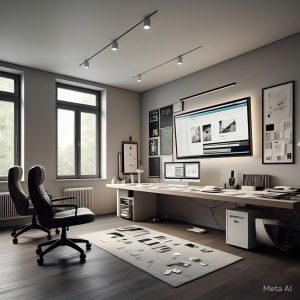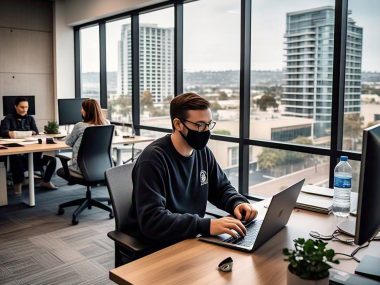
Remote interior design jobs are transforming the way designers work, offering a flexible and creative career path without requiring in-person client meetings. As technology advances, designers can now work from home or any location, using digital tools to create beautiful, functional spaces for clients worldwide. The demand for virtual design services continues to grow, making remote interior design jobs an excellent option for professionals seeking work-life balance and financial independence.
What Are Remote Interior Design Jobs?
Remote interior design jobs involve planning, designing, and executing interior projects without the need for physical site visits. Through digital platforms, designers can communicate with clients, develop design concepts, and deliver professional interior solutions virtually. These roles can range from working for a design firm to freelancing or running a personal design business.
Many companies now hire professionals for remote interior design jobs, enabling designers to work on residential, commercial, and hospitality projects from anywhere in the world. With virtual consultations, 3D modeling, and mood boards, designers can efficiently bring a client’s vision to life without being physically present.
Responsibilities of Remote Interior Design Jobs
Remote interior design jobs require professionals to handle various tasks, including:
•Client Consultations – Conducting video meetings, phone calls, and emails to understand client preferences.
•Concept Development – Creating digital mood boards, color palettes, and design inspirations.
•3D Visualization – Using software like SketchUp, AutoCAD, and Adobe Photoshop to generate realistic renderings.
•Furniture and Decor Selection – Recommending furniture, lighting, and accessories that match the client’s style.
•Space Planning – Designing functional layouts to maximize space and aesthetics.
•Project Management – Overseeing design implementation remotely, coordinating with vendors, and ensuring deadlines are met.
By effectively handling these tasks, professionals in remote interior design jobs can deliver outstanding results and maintain strong client relationships.
Skills Required for Remote Interior Design Jobs
Remote interior design jobs require a mix of creative, technical, and communication skills. Key skills include:
•Interior Design Knowledge – Understanding design principles, space planning, and styling.
•Software Proficiency – Expertise in AutoCAD, SketchUp, Adobe Creative Suite, and 3D rendering tools.
•Strong Communication – Clear email, phone, and video communication with clients and vendors.
•Project Management – Ability to manage multiple projects, deadlines, and client expectations.
•Problem-Solving – Quickly resolving design challenges and adapting to client needs.
•Marketing Skills – Promoting services through social media, websites, and online portfolios.
By honing these skills, professionals can secure more remote interior design jobs and build a successful career.
Benefits of Remote Interior Design Jobs
Remote interior design jobs offer numerous benefits for creative professionals, including:
•Flexible Schedule – Choose working hours and manage projects at your own pace.
•Global Opportunities – Work with clients from different locations and cultures.
•Lower Costs – Save money on commuting, office rent, and travel expenses.
•Creative Freedom – Develop unique design styles without corporate restrictions.
•Work-Life Balance – Enjoy more time for personal and professional growth.
•Higher Earning Potential – Earn through freelance work, consultation fees, and project-based contracts.
These advantages make remote interior design jobs an attractive career choice for designers worldwide.

Challenges of Remote Interior Design Jobs
Remote interior design jobs come with unique challenges that require adaptability and problem-solving skills. Some common challenges include:
•Limited On-Site Access – Designers must rely on client-provided measurements and photos.
•Communication Barriers – Misinterpretations may arise without in-person discussions.
•Marketing Efforts – Freelancers must actively promote their services to attract clients.
•Time Zone Differences – Working with international clients may require flexible schedules.
•Project Coordination – Ensuring smooth execution of designs remotely can be challenging.
Overcoming these obstacles can help professionals thrive in remote interior design jobs and build a strong reputation.
Where to Find Remote Interior Design Jobs
Remote interior design jobs are available on various platforms that connect designers with clients and employers. Some of the best places to find opportunities include:
•Upwork – A freelance marketplace offering remote interior design projects.
•Fiverr – A platform where designers can sell virtual design services.
•Houzz – An interior design network for professionals to showcase their portfolios.
•PeoplePerHour – Ideal for finding freelance design gigs.
•LinkedIn – A professional network with job postings for remote designers.
•FlexJobs – A job board specializing in remote and flexible job opportunities.
Exploring these platforms can help professionals secure remote interior design jobs and grow their careers.
Salary Expectations for Remote Interior Design Jobs
Remote interior design jobs offer competitive salaries based on experience, project complexity, and client budget. General salary ranges include:
•Entry-Level Designers – $30,000 – $50,000 per year
•Freelance Interior Designers – $50 – $150 per hour
•Senior Interior Designers – $70,000 – $100,000 per year
•3D Rendering Specialists – $40,000 – $80,000 per year
Freelancers in remote interior design jobs can increase their earnings by offering premium services and working with high-end clients.
How to Succeed in Remote Interior Design Jobs
To excel in remote interior design jobs, follow these tips:
•Build an Online Portfolio – Showcase your best work on a professional website or social media.
•Network with Clients – Join online design communities and forums.
•Stay Updated on Trends – Keep up with the latest design styles, materials, and technologies.
•Enhance Technical Skills – Learn new software tools and design techniques.
•Offer Exceptional Customer Service – Provide timely communication and high-quality work.
By implementing these strategies, professionals can establish themselves as experts in remote interior design jobs.
Future Trends in Remote Interior Design Jobs
Remote interior design jobs are evolving with new technologies and consumer demands. Key trends shaping the industry include:
•Virtual Reality (VR) and Augmented Reality (AR) – Offering immersive design experiences.
•Sustainable Design – Increasing demand for eco-friendly materials and energy-efficient solutions.
•E-Design Services – More clients seeking affordable online design packages.
•AI-Powered Design Tools – AI helping with space planning and color selection.
•Social Media Influence – Designers using Instagram, Pinterest, and TikTok to attract clients.
Adapting to these trends will help professionals remain competitive in remote interior design jobs.
Conclusion
The Growing Demand for Remote Interior Design Jobs
Remote interior design jobs provide creative professionals with the opportunity to work from anywhere while designing stunning interiors for clients worldwide. With flexible work schedules, financial growth, and advanced digital tools, this career path offers limitless potential.
As businesses and homeowners continue to seek virtual design solutions, now is the perfect time to explore remote interior design jobs. Whether you’re a seasoned designer or just starting out, the future of interior design is digital—start your remote career today!





